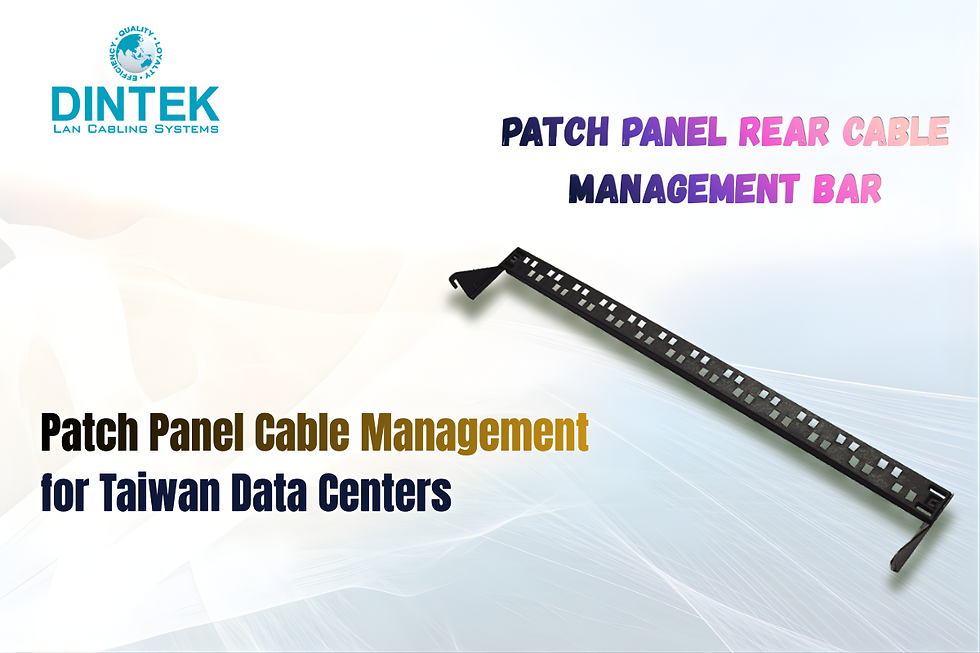The Future of Cable Management: Category 8 Innovations
- dinteklancabling
- Apr 3, 2024
- 4 min read
Category 8 cables are the latest development introduced in recent years proving to be a game-changer in cable management. It allows information to travel faster and safer. Category 8 cables offer significant improvements over previous cable categories like Cat 6a and Cat 7, making them ideal for applications requiring fast connectivity. In this blog, we'll talk about why it's important to keep the cables organized in Category 8 networks to make sure they work their best.
About Category 8 Cables
Designed to provide faster and more reliable data transmission category 8 cables are the newest edition in ethernet cabling. Cat 8 cables support higher frequencies up to 2000 MHz, enabling data rates of up to 40 gigabits per second over short distances.
One of the key characteristics of Cat 8 networks is their ability to support distances of up to 30 meters, making them well-suited for high-density environments such as data centres and enterprise networks. Additionally, Cat 8 cables are backward compatible with previous Ethernet standards, allowing them to be used in conjunction with Cat 6, Cat 6a, and Cat 7 cables and equipment.

Overall, Cat 8 networks offer unparalleled speed and performance, making them ideal for applications requiring ultra-fast data transmission, such as streaming high-definition video, cloud computing, and virtual reality.
Advantages of Cat 8 over previous cable categories
Faster Speed: Cat 8 cables support much higher data transfer rates, with speeds of up to 40 gigabits per second over short distances. This is a considerable improvement over the maximum speeds of 10 Gbps for Cat 6 and Cat 6a cables.
Increased Bandwidth: With support for frequencies up to 2000 MHz, Cat 8 cables provide greater bandwidth compared to other cables. This allows for more data to be transmitted simultaneously, accommodating the growing demands of modern network applications.
Improved Shielding: Cat 8 cables typically feature better shielding to minimize electromagnetic interference (EMI) and crosstalk, ensuring more reliable and stable connections. This is especially important in high-density environments where multiple cables are installed nearby.
Longer Support Distance: While Category 8 cables are primarily designed for short-distance applications, they can still support distances of up to 30 meters, which is sufficient for many enterprise and data centre deployments. This exceeds the maximum distances supported by Cat 6, Cat 6a and Cat 7 cables.
Future-Proofing: Investing in Cat 8 infrastructure provides a level of future-proofing for network upgrades and expansions. As network demands continue to increase, Cat 8 cables offer a higher performance ceiling compared to previous cable categories, potentially extending the lifespan of the network infrastructure.
Backward Compatibility: Cat 8 cables are backward compatible with existing Ethernet standards, allowing them to be used alongside Cat 6, Cat 6a, and Cat 7 cables and equipment. This ensures seamless integration with legacy systems while offering the benefits of Cat 8 performance where needed.
Key Components of Cable Management in Cat 8 Networks
Effective cable management in Category 8 networks is essential to optimize the performance and ensure reliable data transmission. Several key components contribute to successful cable management in Cat 8 networks:
Cable Routing Solutions: Proper cable routing involves planning and implementing pathways for cables to follow throughout the network infrastructure. Cable trays, raceways, and conduits are commonly used to support and guide cables along designated routes, minimizing cable congestion and preventing tangling or damage.
Equipment for Cable Organisation: To assist in arranging and safeguarding cables inside Cat 8 networks, a range of equipment and attachments are available. Cable ties, straps, and wraps are used to bundle and fasten cables together, keeping them neat and orderly. Additionally, cable management panels and racks provide mounting solutions for organizing cables within server racks and equipment cabinets.
Cable Labels and Identification: Labeling cables with clear and descriptive markers is essential for easy identification and troubleshooting. Cable labels should include information such as cable type, length, and termination points, enabling network technicians to quickly locate specific cables and identify their intended connections.
Spacing and Separation: Maintaining adequate spacing and separation between cables is crucial to minimize interference and ensure optimal signal integrity in Cat 8 networks. Properly spaced cables reduce the risk of electromagnetic interference (EMI) and crosstalk, preserving signal quality and reliability.
Segregation of Power and Data Cables: It's important to separate power cables from data cables to prevent electrical interference and potential signal degradation. Keeping power and data cables in separate pathways or using shielded cables for power distribution helps maintain signal integrity and reduces the risk of electromagnetic interference.
Grounding and Bonding: Proper grounding and bonding practices are essential for electrical safety and effective EMI mitigation in Cat 8 networks. Grounding cables and equipment ensures that electrical currents are safely dissipated, reducing the risk of electrical hazards and minimizing the potential for interference with data signals.
Flexible Cable Management Solutions: Cat 8 networks may undergo changes and expansions over time, requiring flexible cable management solutions that can adapt to evolving requirements. Modular cable management systems and adjustable cable routing components provide flexibility to accommodate future changes and upgrades without the need for extensive rework or disruption.
Conclusion
Effective cable management is crucial for getting the best performance out of Cat 8 networks, helping to prevent issues like signal loss and interference. It ensures faster, safer, and more reliable data transmission.
Invest in good cable management practices with DINTEK to ensure efficient, reliable, and ready for future growth.



Comments